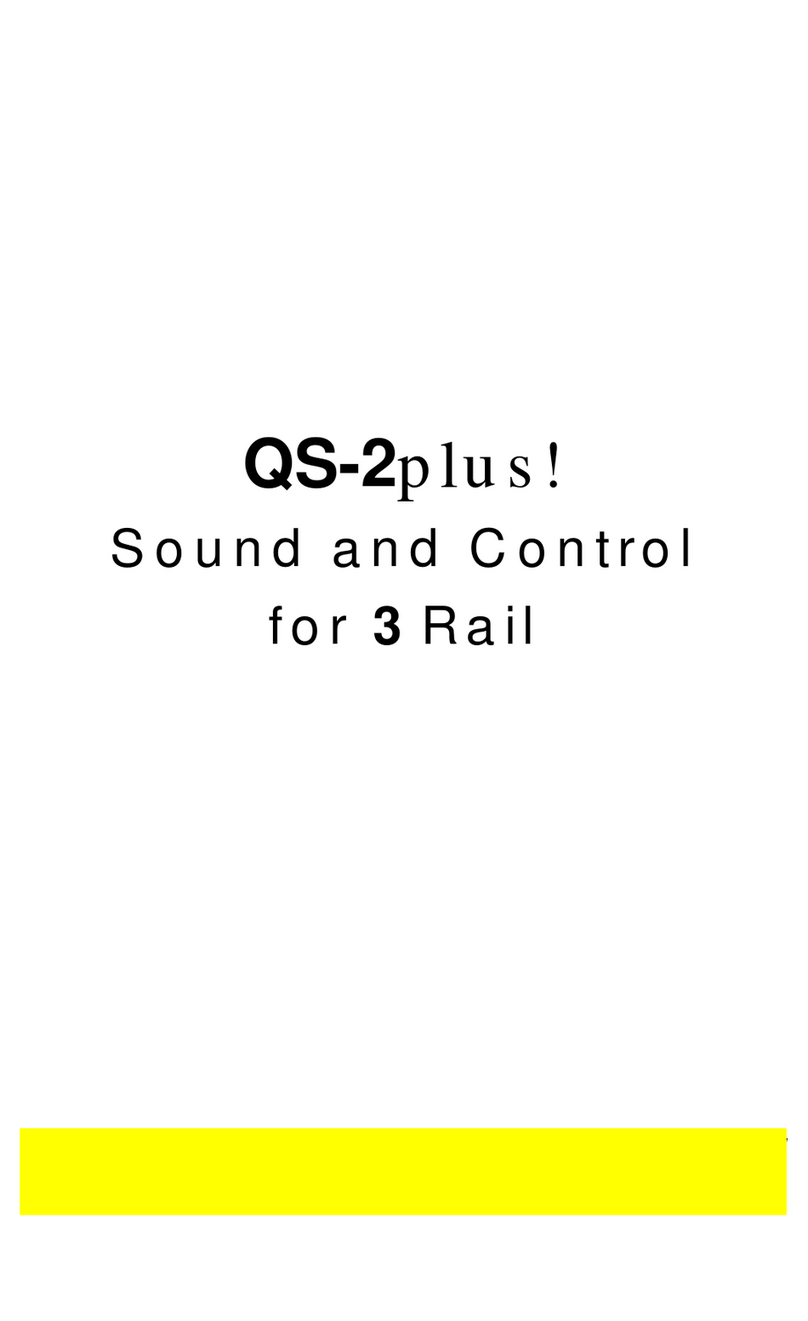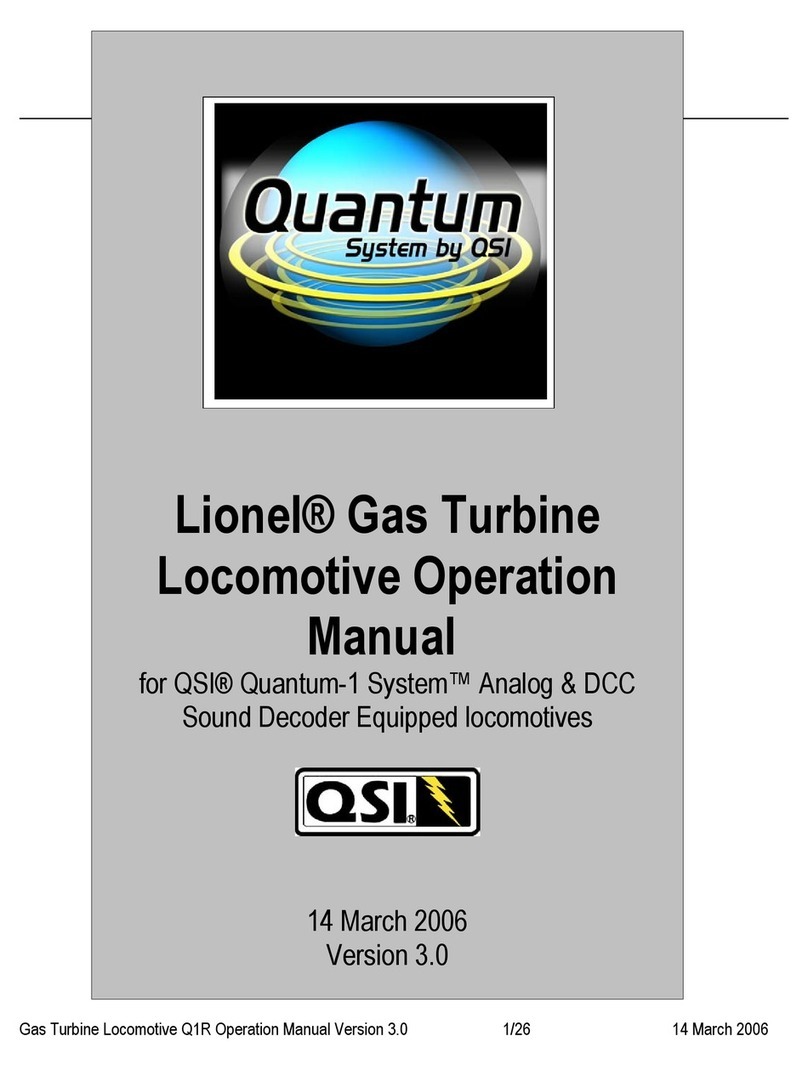
Standard Throttle Control™ (STC™) and Regulated Throttle Control™ (RTC™)
Quantum locomotives have two types of Analog throttle control available, Standard and Regulated. Both Standard Throttle Control (STC)
and Regulated Throttle Control (RTC) will apply more power to the motor as a function of increasing track voltage beginning at the V-Start
setting. RTC includes an Inertial Control feature that prevents the locomotive from reacting quickly to changes in voltage or minor
impediments to motion such as misaligned track joints, tight curves, rough turn-outs, etc. A locomotive under STC may come to an
unrealistic halt from a raised track joint or a drop in voltage15 while the same locomotive under RTC, with its Inertial Control, will continue at
the same speed. RTC operates your locomotive as though it has the mass and inertia of a prototype locomotive; your locomotive will resist
changes in speed once it is moving and will resist starting up quickly if at rest. You will be able to operate your locomotive at very slow
prototypical speeds without having to adjust your throttle continually to maintain speed.
While small obstacles will not affect the locomotives speed under RTC, a continual force will slow your train down, just like the prototype.
For instance, if your Electric locomotive encounters an upward grade under RTC, it will eventually slow down. Providing more throttle will
slowly accelerate it back to speed. The same locomotive under STC would quickly slow down or stop if it encountered an upward grade.
The type of throttle control also affects how your engine decelerates. Under STC, your locomotive will respond quickly to a reduction in
track voltage. Under RTC, your locomotive will decelerate slowly as you bring the throttle down. If you bring the throttle down below V-
Start, the locomotive will slowly come to a stop. You can however, force a locomotive to slow down rapidly under RTC by bringing the
throttle down quickly; this reduces the power available to the motor inertial control circuit and forces the speed to decrease faster than RTC
would normally allow Once the locomotive slows down and regains normal RTC operation, it will continue to decelerate slowly according to
its built-in Inertia and Load setting. For instance, if your locomotive was running at top speed and you quickly reduced the track voltage to
just below V-Start (where the locomotive would normally be stopped) the locomotive would at first slow down rapidly as you reduced the
available power to the motor. After this initial rapid slow down, the locomotive would decelerate at a rate determined by RTC Inertial
Control and Load and finally coast to a stop
STC and RTC are selected under Analog Programming (see next section). The default is RTC.
Train Load
You can set your Electric locomotive to have any of 16 different Load levels, which represent added inertia from rolling stock (see Analog
Programming, Option 2, in next section). The higher the Load setting, the greater the inertia effect during acceleration and deceleration. As
you increase track voltage, the motor is provided an increasing portion of that voltage which, depending on the Load setting, will gradually
accelerate the locomotive realistically until it reaches full speed. Level 0 is the default, which is no Load.
Under STC, the level 0 Load setting will allow your locomotive to accelerate or stop as quickly as the internal flywheels will allow. Under
RTC, level 0 will add no additional Load to the Intrinsic Inertia already provided by RTC. For any Load setting from 1-15, your Electric
locomotive will take longer to change speed under either STC or RTC. At level 1, it will take approximately 15 seconds more to achieve full
speed at max throttle16; at level 15, it will take over 3 ½ minutes to achieve full speed. In addition, at higher Load settings, your locomotive
will decelerate more slowly as you decrease your throttle.
Sound of Power™
Your Electric locomotive will produce Sound-of-Power labored Electric Traction Motor sound effects under RTC or under STC as long as
you have selected any of the Load settings from level 1 to 15. Under acceleration, the Electric Traction Motor sounds will be more labored
until the locomotive has achieved its final speed where it will then produce standard sounds appropriate to its throttle setting. Under
deceleration, the Traction Motor sounds are less labored until it achieves its final speed where it will again produce standard Electric
Traction Motor sounds appropriate to its throttle setting.
Helpers
Prototype Helpers are locomotives that are used to provide extra power and/or braking for a heavily loaded train. These Helper locomotives
can be part of the head-end consist or as mid-train helpers or as pushers at the end of the train. Helper locomotives behave differently than
the train’s lead locomotive. Their horns and bells are usually not operated, and their lighting options are different or not used at all.
When you make up your train using more than one locomotive, the Quantum System allows you to easily program how each locomotive
will behave by selecting between a Lead engine, Mid Helper, End Helper, or Pusher. Each type of Helper locomotive has different lighting
and sound characteristics as described in the table in the next section on Analog Programming, Option 3, page 7.
15 For instance, blowing the Horn takes power and can reduce track voltage substantially and quickly. Under STC at low speed, blowing the horn can stop your locomotive. Under
RTC blowing the Horn will not cause your locomotive to stop or slow abruptly.
16 Some unloaded power packs produce excessive voltage at max throttle and will activate the Quantum high-voltage circuit breaker. When this happens, your locomotive will skip
and emit a series of hoots until the power is reduced to a lower voltage (see Troubleshooting, page 19).
Electric Loco Q1 w/Volume Pot Operation Manual, Version 2.8 5/21 8 March 2006






























